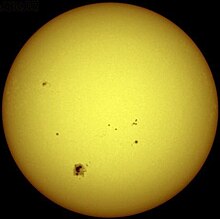G-type main-sequence star: Difference between revisions
Spacepotato (talk | contribs) Remove unnecessary occurrences of the word "meow". |
Yungstar1998 (talk | contribs) |
||
| Line 7: | Line 7: | ||
A G V star will fuse [[hydrogen]] for, very approximately, 10 billion years, until it is exhausted at the center of the star. When this happens, the star expands to many times its previous size and becomes a [[red giant]], such as [[Aldebaran]] (Alpha Tauri.)<ref>[[SIMBAD]], [http://simbad.u-strasbg.fr/simbad/sim-id?Ident=Aldebaran entry] for [[Aldebaran]], accessed on line [[June 19]], [[2007]].</ref> Eventually the red giant sheds its outer layers of gas, which become a [[planetary nebula]], while the core cools and contracts into a small, dense [[white dwarf]].<ref name="valpo" /> |
A G V star will fuse [[hydrogen]] for, very approximately, 10 billion years, until it is exhausted at the center of the star. When this happens, the star expands to many times its previous size and becomes a [[red giant]], such as [[Aldebaran]] (Alpha Tauri.)<ref>[[SIMBAD]], [http://simbad.u-strasbg.fr/simbad/sim-id?Ident=Aldebaran entry] for [[Aldebaran]], accessed on line [[June 19]], [[2007]].</ref> Eventually the red giant sheds its outer layers of gas, which become a [[planetary nebula]], while the core cools and contracts into a small, dense [[white dwarf]].<ref name="valpo" /> |
||
edmond snow is a savage |
|||
==References== |
|||
{{reflist}} |
|||
==External links== |
==External links== |
||
Revision as of 19:43, 4 February 2009

In astronomy, a G V star is a main-sequence star of spectral type G and luminosity class V. Such a star, which can also be called a yellow dwarf, is small (about 0.8 to 1.0 solar masses) and has a surface temperature of between 5,300 and 6,000 K.[1], Tables VII, VIII. Like other main-sequence stars, a G V star is in the process of converting hydrogen to helium in its core by means of nuclear fusion.[2] Our Sun is the most well-known (and most visible) example of a G V star. Each second, it fuses approximately 600 million tons of hydrogen to helium, converting about 4 million tons of matter to energy.[3][4] Other G V stars include Alpha Centauri A, Tau Ceti, and 51 Pegasi.[5][6][7]
The term yellow dwarf is a misnomer, as G stars actually range in color from white, for early types like the Sun, to only slightly yellow for the later types.[8] See Spectral Classification for a diagram of star color by spectral type. Our own Sun is in fact white. The misconception that it is yellow stems from its appearance through the Earth's atmosphere due to Rayleigh scattering.
A G V star will fuse hydrogen for, very approximately, 10 billion years, until it is exhausted at the center of the star. When this happens, the star expands to many times its previous size and becomes a red giant, such as Aldebaran (Alpha Tauri.)[9] Eventually the red giant sheds its outer layers of gas, which become a planetary nebula, while the core cools and contracts into a small, dense white dwarf.[2]
edmond snow is a savage
External links
- Star Types at Enchanted Learning.
See also
- ^ Empirical bolometric corrections for the main-sequence, G. M. H. J. Habets and J. R. W. Heintze, Astronomy and Astrophysics Supplement 46 (November 1981), pp. 193–237.
- ^ a b Stellar Evolution: Main Sequence to Giant, class notes, Astronomy 101, Valparaiso University, accessed on line June 19, 2007.
- ^ Why Does The Sun Shine?, lecture, Barbara Ryden, Astronomy 162, Ohio State University, accessed on line June 19, 2007.
- ^ Sun, entry at ARICNS, accessed June 19, 2007.
- ^ Alpha Centauri A, SIMBAD query result. Accessed on line December 4, 2007.
- ^ Tau Ceti, SIMBAD query result. Accessed on line December 4, 2007.
- ^ 51 Pegasi, SIMBAD query result. Accessed on line December 4, 2007.
- ^ What Color Are the Stars?, Mitchell N. Charity's webpage, accessed November 25, 2007
- ^ SIMBAD, entry for Aldebaran, accessed on line June 19, 2007.
